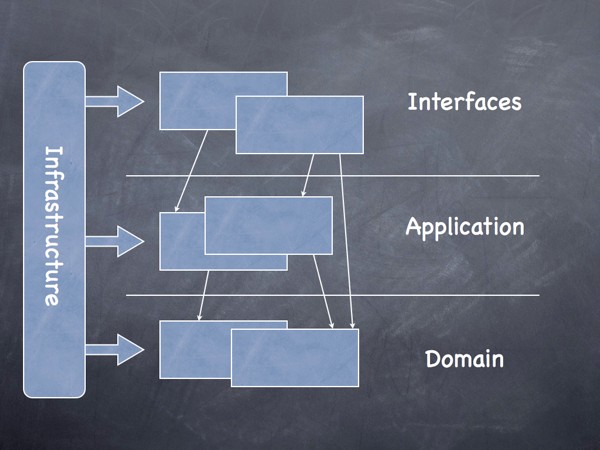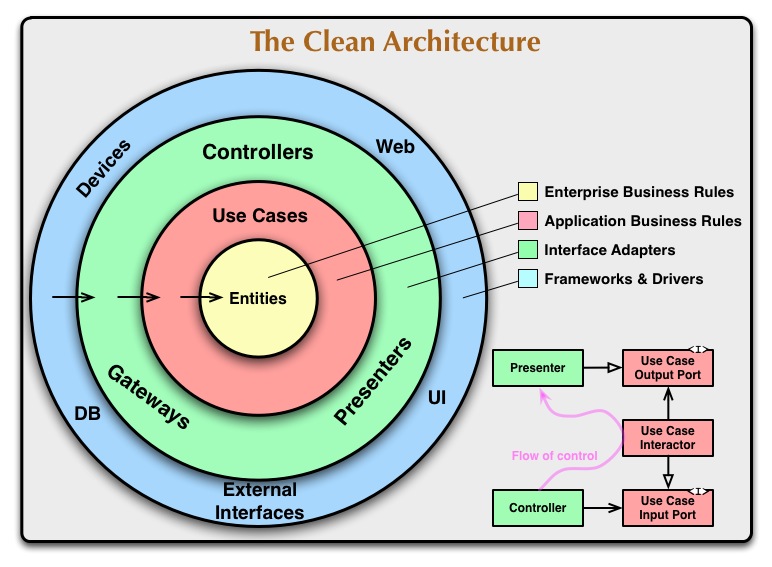docker-compose up -dIn a browser, open http://localhost:5000/hello.
Software design is a very hard thing. From years, a trend has appeared to put the business logic, a.k.a. the (Business) Domain, and with it the User, in the heart of the overall system. Based on this concept, different architectural patterns was imaginated.
One of the first and main ones was introduced by E. Evans in its Domain Driven Design approach.
Based on it or in the same time, other applicative architectures appeared like Onion Architecture (by. J. Palermo), Hexagonal Architecture (by A. Cockburn) or Clean Architecture (by. R. Martin).
This repository is an exploration of this type of architecture, mainly based on DDD and Clean Architecture, on a concrete and modern JavaScript application.
The application follows the Uncle Bob "Clean Architecture" principles and project structure :
project folder
├── CHANGELOG.md # Project's change log
├── Dockerfile # Dockerfile for production
├── LICENSE # Project's license file
├── README.md # General project documentation
├── commitlint.config.js # Configuration for commitlint
├── dev.Dockerfile # Dockerfile for development
├── docker-compose.yml # Docker Compose configuration
├── e2e # End-to-end tests
│ ├── jest.config.js
│ ├── resources
│ │ └── AuthController.test.ts
│ └── setup.ts
├── jest.config.json # Jest configuration
├── nodemon.json # Configuration for Nodemon
├── package-lock.json # NPM dependency version lock
├── package.json # NPM project configurations
├── src # Application source code
│ ├── application # Application services layer
│ ├── domain # Core domain business layer
│ ├── infrastructure # Frameworks, drivers, and tools
│ └── interfaces # Adapters and formatters for use cases and entities
├── test # Unit and functional tests
│ ├── application
│ │ └── use_cases
│ ├── infrastructure
│ │ ├── repositories
│ │ └── security
│ └── interfaces
│ ├── controllers
│ ├── pagination.test.ts
│ └── serializers
├── tsconfig-build.json # TypeScript configuration for building
└── tsconfig.json # TypeScript configuration for the project
The overriding rule that makes this architecture work is The Dependency Rule. This rule says that source code dependencies can only point inwards. Nothing in an inner circle can know anything at all about something in an outer circle. In particular, the name of something declared in an outer circle must not be mentioned by the code in the an inner circle. That includes, functions, classes. variables, or any other named software entity.
src. https://blog.cleancoder.com/uncle-bob/2012/08/13/the-clean-architecture.html#the-dependency-rule
Server, routes and plugins can be considered as "plumbery-code" that exposes the API to the external world, via an instance of Express server.
The role of the server is to intercept the HTTP request and match the corresponding route.
Routes are configuration objects whose responsibilities are to check the request format and params, and then to call the good controller (with the received request). They are registered as Plugins.
Plugins are configuration object that package an assembly of features (ex: authentication & security concerns, routes, pre-handlers, etc.) and are registered at the server startup.
Controllers are the entry points to the application context.
They have 3 main responsibilities :
- Extract the parameters (query or body) from the request
- Call the good Use Case (application layer)
- Return an HTTP response (with status code and serialized data)
A use case is a business logic unit.
It is a class that must have an execute method which will be called by controllers.
It may have a constructor to define its dependencies (concrete implementations - a.k.a. adapters - of the port objects) or its execution context.
Be careful! A use case must have only one precise business responsibility!
A use case can call objects in the same layer (such as data repositories) or in the domain layer.


